Why YOU Need the ISOMAX:
The Rock-Solid Science Behind Isometrics
What is the ISOMAX? Imagine this, for a moment...
Imagine a device you could carry around with you, solid as steel but weighing only a few pounds, which takes up less than two square feet of floor space—no need for a commercial or home gym.
Imagine being able to perform all the very best strength drills on that device—deadlifts, squats, rows, curls, presses, shrugs, triceps presses, grip holds, and so on—with up to a thousand pounds resistance.
Imagine if that device could, with digital precision, display how much force output you are generating (in pounds or kilos), calculate your maximum and average workload, and even audibly tell you when you’ve hit your target weight or when your set is done.
Imagine that device for a price less than an Olympic barbell set.
How much would that kind of device amplify your training? This is the ISOMAX.
THE SCIENCE OF ISOMETRICS
The ISOMAX is a twenty-first century, digital incarnation of the old school, tried-and-true isometric chain-and-bar device. These units have been around for decades; they were used by martial artists, weightlifters and bodybuilders from the 1950s onwards and became a highly popular tool.
Isos went out of fashion around the time of Bruce Lee’s mysterious death, for reasons that had nothing to do with the effectiveness of this ingeniously simple method: the emergence of anabolic steroids—and the seep of flakiness and trendiness into the fitness world.
It is time to bring this secret weapon back.
-Pavel Tsatsouline
These athletes knew by logic and experiment what science has since proven—that isometric training has enormous benefits, undreamt of by most modern athletes and coaches.
...Here are the top ten.
THE TOP TEN PROVEN BENEFITS OF ISOMETRICS
BENEFIT #1: Isos make you freakishly strong—fast.
Isometric exercise is unique in its ability to rapidly increase muscle strength and tone muscle faster than that seen for dynamic exercise.
-Petrofsky, et al.1
Numerous studies have found that isometric training strengthens muscles faster than dynamic, moving methods.2 The original German studies (Muller and Hettinger, 1954) showed that isometrics performed daily increased the strength of subjects by 5% per week. That’s incredible!
Why is isometrics so remarkably effective at increasing strength?
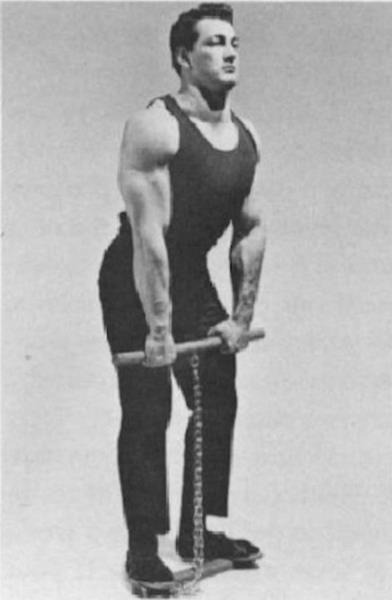 The answer lies in the Force Velocity Curve. This physiological principle states that muscles can only move quickly when they are exerting low amounts of force.3 For example—you can pick up a one-pound weight at near maximum speed; a two-hundred pound weight will make you move slower; and when you are dealing with the heaviest load you can handle, your muscles will not be moving at all. In other words, only static, isometric exercise allows the muscles to express their maximum force levels. This in turn impels your nervous system to recruit as many motor units as possible (Hebb’s Rule). Amazingly, isometrics is capable of recruiting almost 100% of a muscle’s motor units.4 This neurological recruitment is at the heart of strength gain.
The answer lies in the Force Velocity Curve. This physiological principle states that muscles can only move quickly when they are exerting low amounts of force.3 For example—you can pick up a one-pound weight at near maximum speed; a two-hundred pound weight will make you move slower; and when you are dealing with the heaviest load you can handle, your muscles will not be moving at all. In other words, only static, isometric exercise allows the muscles to express their maximum force levels. This in turn impels your nervous system to recruit as many motor units as possible (Hebb’s Rule). Amazingly, isometrics is capable of recruiting almost 100% of a muscle’s motor units.4 This neurological recruitment is at the heart of strength gain.
BENEFIT #2: Isos add hard muscle rapidly and effectively.
It is clear that isometric training can result in significant hypertrophy.
-Fleck, et al.5
There is an old wives’ tale in some gyms that isometrics—while being great at adding strength and "tone"—will not increase muscle size. There is zero scientific backing for this idea—in fact, the studies tell us the exact opposite. Isometrics is very effective at promoting hypertrophy, when used correctly.6
Muscle growth as an adaptation is largely the product of anaerobic metabolic fatigue within the muscles.7 There is nothing magic about picking weights up and down—you can fatigue your muscles equally well using isometrics. In fact, isometrics has greater potential from a "time-under-tension" perspective as there are no mini-rests between reps, or during less demanding points of technical leverage, as is the case with regular weight-training.

Remember the last time you had to move furniture or a fridge, holding it up by keeping your arms in a static curl position underneath? Do you recall how quickly it got "heavy" as your biceps and forearms began to burn and cramp? That’s muscular fatigue. It’s the key to growth.
Forget the old myths and "broscience". Metastudies confirm that isometric exercise can produce advanced levels of hypertrophy.8 This is not just paper theory, either. Sophisticated research studies have shown that isometric training produces equal muscle growth to regular, concentric training.9 (Another benefit: isometrics actually increases muscle density to a greater degree than regular methods.10 If you want to tone and harden up, isos are king.)
BENEFIT #3: Isos sessions are super-quick to perform and optimally efficient.
It should also be said that isometric exercises are more efficient (than dynamic exercises): they produce their effects with a much smaller training effort.
-Dr John Atha, Exercise and Sports Science vol.11
One of the traditional arguments in favor of isometric training is that iso sessions are highly efficient and rapid to complete while remaining powerfully effective. The science has agreed since the early days.12 In fact, we can go further: because isometric training facilitates high-intensity contractions, with no wasted fluctuations in intensity (as can be found in traditional dynamic "sets and reps" training), isometrics are the most efficient form of strength-building methodology possible. This is simple math. Legendary Soviet strength scientist Yuri Verkhoshanky gives us this telling analysis:
The (isometric) training is very productive, if the time expended is considered. Each 6-second isometric contraction is equivalent in its effect to many dynamic contractions (of the ballistic type) in which maximal force lasts no more than 0.1 second. From a practical standpoint this means that 10 minutes of isometric tension in specially selected exercises can replace a fatiguing hour of training with weights.13
In short: isometric training can produce superior results in less time.
BENEFIT #4: Isos protect the joints and reduce pain.
A primary advantage of isometric exercise in musculoskeletal rehabilitation lies in the opportunity for localized muscle exercise without moving joints. Strength increases more rapidly in isometric than in dynamic exercises.
-Kuprian, Physical therapy for Sports14
A long-held criticism of resistance training is that it can cause injury and—when heavy weights are employed—cause wear-and-tear on the joints, irritating old injuries and even promoting arthritis over time.
Isometrics are radically safer than all forms of dynamic exercise, and the science behind this is well known (e.g., Hooke’s Law).15 Acute injuries in resistance training—sprains, strains and tears—are generally caused by external loads exceeding the athlete’s strength capacities, often due to momentum or inertia. In isometrics there is no movement: there is zero momentum or inertia, and the loads used are 100% self-regulated by the athlete’s own strength levels. It’s difficult to conceive of a safer method of resistance training.
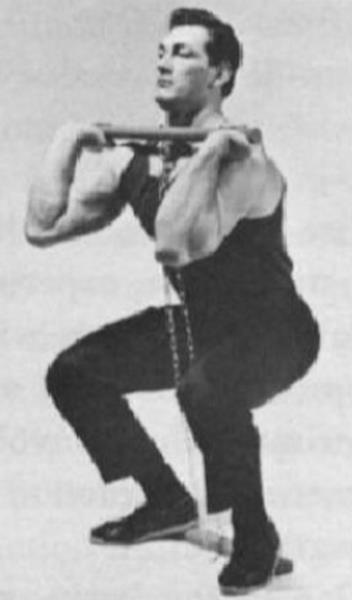 Chronic, "wear-and-tear" effects of heavy weight-training (and other forms of dynamic exercise) are caused by internal abrasive forces.16 These aches and pains are often (wrongly) assumed to just be part of "the game" of strength training. When you squat or bench press with a heavy load, cartilage, bone and soft tissues rub together. This causes abrasion damage which can reduce synovial fluid and roughen intra-anatomic gliding surfaces, increasing mechanical friction in joints and making the problem worse over time. The damage is caused by load x movement. If you want to build superior strength, you can’t remove the load: but you can remove the movement—i.e., isometric training. Athletes who can no longer squat or press with a barbell have found that they can squat and press with higher loads than ever using isometrics, with no pain—purely due to the sudden absence of internal mechanical abrasion in the joints.
Chronic, "wear-and-tear" effects of heavy weight-training (and other forms of dynamic exercise) are caused by internal abrasive forces.16 These aches and pains are often (wrongly) assumed to just be part of "the game" of strength training. When you squat or bench press with a heavy load, cartilage, bone and soft tissues rub together. This causes abrasion damage which can reduce synovial fluid and roughen intra-anatomic gliding surfaces, increasing mechanical friction in joints and making the problem worse over time. The damage is caused by load x movement. If you want to build superior strength, you can’t remove the load: but you can remove the movement—i.e., isometric training. Athletes who can no longer squat or press with a barbell have found that they can squat and press with higher loads than ever using isometrics, with no pain—purely due to the sudden absence of internal mechanical abrasion in the joints.
Here’s another exciting perk—as well as preventing injuries, recent studies have actually found that isometric training radically reduces joint pain caused by old injuries. Dr Ebonie Rio, a specialist researcher in sports science, makes the effects clear:
A single bout of heavy isometrics reduced tendon pain pretty much instantly (and lasted at least 45 minutes), it also reduced the associated muscle inhibition, resulting in an increase in muscle strength.
...The most important thing from the research? Tendons seem to love heavy isometric load and it reduced tendon pain immediately.17
If you have pain and injuries which are negatively affecting your strength development, isometrics is the answer. If you don’t have pain or injuries, but want to avoid them, isometrics is also the answer.
BENEFIT #5: You can train isos more often—to make faster progress
We know that muscle recovery from isotonic exercise occurs more slowly than recovery from isometric exercise, but the recovery curves have similarities.
-Therapeutic Exercise for Musculoskeletal Injuries18
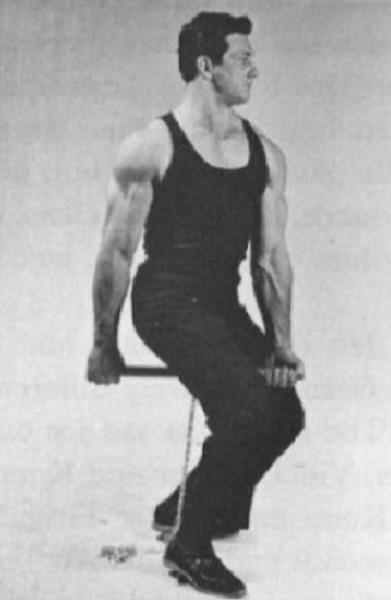 Anyone who is used to heavy weight training then experiments with isometrics will immediately find that isos don’t seem to exhaust you the way regular weight training does. You finish your sessions fresh and energized, and wake up less sore and stiff the next day.
Anyone who is used to heavy weight training then experiments with isometrics will immediately find that isos don’t seem to exhaust you the way regular weight training does. You finish your sessions fresh and energized, and wake up less sore and stiff the next day.
At first glance, this effect seems contradictory: how can this be, when you are dealing with maximal, or near-maximal loads? The answer has to do with myology—the science of muscle. Sore muscles after training are the result of microtrauma on a cellular level. When you lift a heavy weight, your muscles move because filaments of protein in units of muscle called sarcomeres are ordered to shorten by the nervous system. This is called the sliding filament theory of muscle contraction.19 If the load the muscles are moving under is heavy, the filaments lose their integrity and "pop"—if enough of those filaments are damaged, it results in inflammation and pain inside the muscles.20 This sarcomere damage results in a chemical cascade which causes the systemic exhaustion and reticence to exercise further which we feel after a heavy weights session.
It’s been established for decades that the major culprit in causing this damage is the eccentric motion—when the muscles lengthen under load.21 During pure isometrics, there is no significant lengthening of the muscles, so this kind of damage and post-training staleness is sliced down to an absolute minimum.
The result: you can practice isometrics every day if you wish to (although you don’t need to, to get strength benefits).22 Also, because isometrics don’t leave you wiped out, they are perfect for athletes who practice other sports or disciplines, and can’t afford to sacrifice all their energy in the weight-room. Isos get you strong while keeping you fresh.
BENEFIT #6: Isometrics make you faster
Think static training will make you slow? Nope—isometric exercise increases speed and explosiveness.23 How?
One must realize that there is a high correlation between maximal isometric strength and movement speed. An increase in strength brings about an increase in movement speed.
-Dr Dietmar Schmidtbleicher24
In studies, isometrics increases speed and jump height just as effectively as explosive training.25
BENEFIT #7: Isometric exercise promotes fat loss
The relationship between isos and fat loss in combination with a sensible diet was studied by the Departments of Physical Therapy in Loma Linda University and Azusa Pacific University in a single-blind randomized study. The results were summarized as follows:
In the present investigation, it is not surprising that with isometric training, there was a marked increase in muscle strength. Thus, the isometric exercise program worked well in terms of increasing muscle strength. It is significant that there was a 20% increase in muscle strength with only seven minutes of work each day.
But the program, while increasing muscle strength, was equally matched by the benefits of weight and girth loss. The loss in girth after 2 weeks for the average person at the waist was 3.0 cm which was equivalent to one pant or dress size. After 4 weeks the loss increased to 3.3 cm. The weight loss for some subjects in the first two weeks was as high as 8.4 kg while after 4 weeks some subjects lost as much as 10.1 kg in in body weight.26
How does this work? While isometrics burns relatively few calories as you perform it, isos do add muscle, which is active tissue—it constantly generates heat (measured as calories) 24 hours per day.27
As an added health bonus, subjects also displayed a dramatic decrease in LDL cholesterol, as well as a significant drop in heart rate and blood pressure.
BENEFIT #8: Isometrics improve cardiovascular capacity
This seems intuitively absurd. How can not moving possibly improve heart health? The answer has to do with the isometric response. When you squeeze your muscles and hold that position—as in isometrics—your blood vessels become mechanically constricted by the tight muscles. As a result, the entire cardiovascular system has to work much harder to pump blood around the body.28 This, in turn, gives the heart and blood vessels an even more powerful workout than conventional "aerobic" exercise.29 The isometric response is well studied and has significant potential benefits for heart health and athleticism.
Therefore, at any given level of oxygen uptake, vigorous isometric exercise raises heart rate, raises systemic vascular resistance, and lowers stroke volume and cardiac output more than dynamic exercise does.
-Lavie, C. J. et al (2001) Exercise and the Heart: Risks, Benefits, and Recommendations for Providing Exercise Prescriptions30
Remarkably, isometrics compares incredibly well to traditional aerobic exercise, previously considered the "gold standard" for heart health: a study involving a 12-week course of aerobic exercise only reduced resting heart rate by around 4 beats per minute31—literally half the amount achieved by isometrics.32
BENEFIT #9: Isometric exercise reduces blood pressure (even better than prescription medication!)
There is a long-held myth that isometrics are bad for your blood pressure. Numerous studies prove that this is untrue—far from being bad for your blood pressure, several papers have indicated that isometrics training is possibly the best way to reduce blood pressure.33
Although isometric or combined isometric and dynamic (resistance) exercise has traditionally been discouraged in patients with coronary disease, it appears that resistance exercise is less hazardous than was once presumed, particularly in patients with good aerobic fitness and normal or near-normal left ventricular (LV) systolic function...
Hence it may be prescribed as part of lifestyle modification and as an adjunct or alternative to antihypertensive therapy in maintaining a desirable blood pressure level that will help in improving quality of life and reducing the risk of cardiovascular disease.
-Sandhu, et al (2014) Scholars Journal of Applied Medical Sciences34
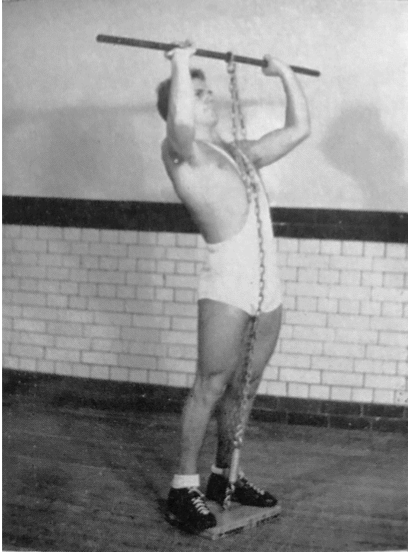 In one study individuals performing isometric exercises threes time per week over eight weeks saw their systolic pressure drop by 12.5 points, and their diastolic plunge by a huge 14.9 points—that’s nearly two points per week.35 This is a huge, potentially life-saving drop—with a low amount of training (only around twenty minutes, three times per week) in a relatively short span of time. In fact, benefits may come even quicker than that—more recent studies have noticed significant blood pressure drops from as little as four weeks of isometric training.36
In one study individuals performing isometric exercises threes time per week over eight weeks saw their systolic pressure drop by 12.5 points, and their diastolic plunge by a huge 14.9 points—that’s nearly two points per week.35 This is a huge, potentially life-saving drop—with a low amount of training (only around twenty minutes, three times per week) in a relatively short span of time. In fact, benefits may come even quicker than that—more recent studies have noticed significant blood pressure drops from as little as four weeks of isometric training.36
(You should always contact your doctor before embarking upon a training program, particularly if you have pre-existing health concerns, including hypertension.)
BENEFIT #10: Isometrics—with the ISOMAX—are convenient
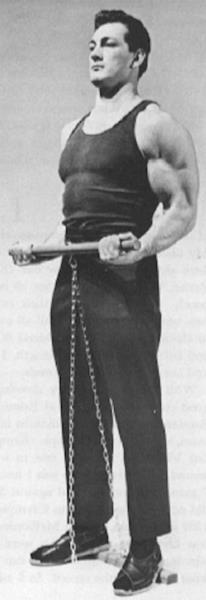 This last one is a no-brainer.
This last one is a no-brainer.
An ISOMAX weighs only a few pounds, has a tiny architectural footprint, can be stored and retrieved in seconds, and can be used in even the smallest of rooms. The device works all muscle groups and a complete, full-body workout can be achieved, in some cases, in just ten minutes. In addition, there is minimal systemic exhaustion afterwards, as can occur with hard cardio and conventional lifting—you can immediately go about your day, energized.
Compare this to the status quo paradigm of driving to the gym, getting changed in the locker room, working out for 45 minutes, taking a shower, driving home, and on and on. In today’s world, this dynamic just doesn’t work for many busy people: even serious athletes.
(And remember: in the long term, not only is the ISOMAX the most convenient training methodology, it will also save you gym fees.)
NEXT-GEN RESISTANCE TRAINING)
There has always been the question, which is more productive, dynamic or isometric exercises? In my opinion, both must be trained.
-Louie Simmons37
Nobody is suggesting that conventional weight training or fitness methods don’t work, or have their place. They do. But if you were looking for the ultimate training methodology—purely based on the science—isometrics may very well take that title. If you want to fulfill your physical potential, you should be using it, ASAP. Even if you are in head-over-heels in love with current training methodologies—barbell or kettlebell training, bodybuilding, CrossFit—isos are so quick and so hugely effective, there’s no reason in the world why you shouldn’t include them in your routine. They will amplify the rest of your training!
So: if isometrics are such a big deal...why isn’t everybody doing them?
The answer is that the technology hasn’t been advanced enough to allow isometrics to be performed progressively and with feedback, outside of a laboratory. With the advent of the ISOMAX, all these issues have been corrected: permanently.
Want to know more about the ISOMAX design features? Find out more, here.
Interested to know how to train using the ISOMAX? Check this article.
Ready? Click here and get your ISOMAX.
In my mind, it (isometrics) is the ultimate strength exercise and it’s in danger of being lost. That can’t be allowed to happen.
-Bill Starr
JOIN THE ISOMETRIC REVOLUTION
In the late nineties Dragon Door revolutionized the strength and conditioning world when we re-introduced kettlebells to Europe and America.
In 2001 Dragon Door revolutionized nutrition when we published Ori Hofmekler’s The Warrior Diet—the first ever book on intermittent fasting.
In 2010 Dragon Door revolutionized the training world again when we revived functional bodyweight strength training worldwide, via the best-selling Convict Conditioning and the Kavadlo Brothers’ books and certs.
Those "in the know" in the fitness world watch Dragon Door very carefully—because this is the House Where Revolutions Begin. And it’s about to happen again. We invite you to join us now!
Still got questions about the science, the design, or the programming of isometrics and the ISOMAX? Contact our research team and we will get you the answers you need, as a priority: isochainproject@gmail.com
...Isometric contraction will develop functional strength more quickly, and more completely, than any other method known to man.
-Bob Hoffman
REFERENCES
1. Petrofsky, J. et al. (2007) Muscle Strength Training and Weight Loss from a Combined Isometric Exercise and Dietary Program: Journal of Applied Research, vol. 7, no. 1
2. Hettinger, T. (1961) Physiology of Strength, ch. III
3. Hay, J. G., Reid, J. G. (1981) The Anatomical and Mechanical Bases of Human Motion
4. Babault, N. et al. (2001) Activation of human quadriceps femoris during isometric, concentric, and eccentric contractions
5. Steven J. Fleck PhD, William Kraemer PhD, Designing Resistance Training Programs Fourth Edition (2014), page 20
6. Jones, D. A., & Rutherford, O. M. (1987) Human muscle strength training: the effects of three different regimens and the nature of the resultant changes: Journal of Physiology, Oct; 391:1-11.
7. Morrissey M. C. et al. (1995) Resistance training modes: Specificity and effectiveness. Medicine and Science in Sports and Exercise, 27.
8. Schoenfeld, B.J., et al. (2017) Strength and Hypertrophy Adaptations Between Low- vs. High-Load Resistance Training: A Systematic Review and Meta-analysis: Journal of Strength and Conditioning Research, Dec; 31(12):3508-3523.
9. Kanehisa, H. et al. (2002) Effects of equivolume isometric training programs comprising medium or high resistance on muscle size and strength: European Journal of Applied Physiology Jun; 87(2):112-9
10. Jones, D. A., & Rutherford, O. M. (1987) Human muscle strength training: the effects of three different regimens and the nature of the resultant changes: Journal of Physiology, Oct; 391:1-11.
11. Atha, J. (1981) Strengthening Muscle, page 55
12. Karpovich, P. B (1959) Physiology of muscular Activity, page 36
13. Verkhoshanky, Y. (2009) Supertraining, chapter 4.2 (6th Edition)
14. Kuprian, W. (1982) Physical Therapy for Sports
15. The Principles of Exercise Therapy (1957) Gardiner, FCSP
16. Davis & Palfrey: Advances in Industrial Ergonomics and Safety, vol. IV
17. Dr Ebonie Kendra Rio (2015) Isometrics Reduce Tendon Pain: Bodyinmind.org
18. Houglum, P. A. PhD (2016) Therapeutic Exercise for Musculoskeletal Injuries, page 195
19. Krans, J. L., PhD The Sliding Filament Theory of Muscle Contraction. Nature Education 3(9):66
20. Morgan, D. L. & Proske, U. (2004) Popping Sarcomere Hypothesis Explains Stretch Induced Muscle Damage
21. Ibid.
22. Hettinger, T. (1961) Physiology of Strength
23. Morrissey M. C. et al. (1995) Resistance training modes: Specificity and effectiveness. Medicine and Science in Sports and Exercise, 27.
24. Morrissey M. C. et al. (1995) Resistance training modes: Specificity and effectiveness. Medicine and Science in Sports and Exercise, 27.
25. Burgess, K. E. et al. (2007) Plyometric vs. isometric training influences on tendon properties and muscle output.
26. Petrofsky, J et al. (2007) Muscle Strength Training and Weight Loss from a Combined Isometric Exercise and Dietary Program: Journal of Applied Research, vol. 7, no. 1
27. National Council on Strength and Fitness: A Pound of Muscle Burns 30-50 Kcal/Day, Really...: www.ncsf.org
28. Lavie, C. J. et al. (2001) Exercise and the Heart: Risks, Benefits, and Recommendations for Providing Exercise Prescriptions
29. Ibid.
30. Ibid.
31. Kang, S-J. et al. (2016) Effects of aerobic exercise on the resting heart rate, physical fitness, and arterial stiffness of female patients with metabolic syndrome
32. Sandhu, J. S. et al. (2014) Effect of Isometric Handgrip Training on Heart Rate and Arterial Pressure in Normotensive Individuals
33. Carlson, D. J. et al. (2014) Isometric exercise training for blood pressure management: a systematic review and meta-analysis
34. Sandhu, J. S. (2014) Effect of Isometric Handgrip Training on Heart Rate and Arterial Pressure in Normotensive Individuals
35. Wiley, R. L. et al. (1992) Isometric exercise training lowers resting blood pressure.
36. Devereux, G. R. et al. (2010) Reductions in resting blood pressure after 4 weeks of isometric exercise training
37. Louie Simmons (2007): The Westside Barbell Book of Methods